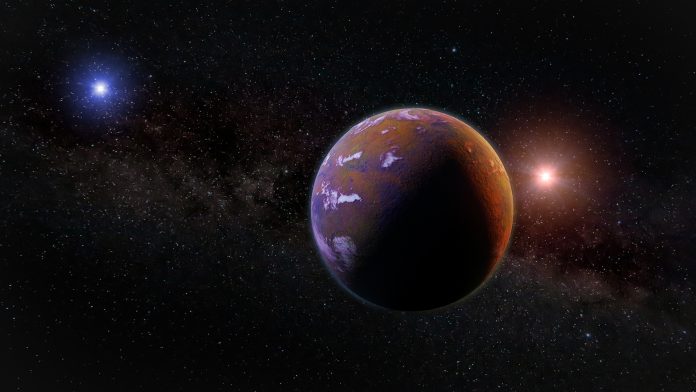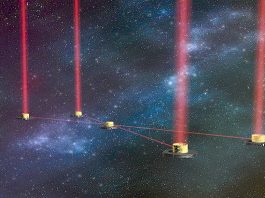A team of astronomers has produced the most accurate model to date of how planet formation occurs in a binary star system, illuminating the mysterious origins of “Tatooine-like” exoplanets.
The team, comprised of researchers from the Max Planck Institute for Extra-terrestrial Physics and the University of Cambridge, have developed a detailed mathematical model of how planets in these binary star systems survive their destructive birth conditions.
Their research is published in Astronomy and Astrophysics.
Binary star systems occur when two stars orbit a common mass, making them gravitationally bound to each other; until now, understanding how planets formed in this chaotic war of gravity has been highly challenging. To solve this interstellar enigma, the team investigated a classification of a binary star system in which the smaller companion star orbits the larger parent star once every 100 years – just like Alpha Centauri – the closest system to Earth.
Dr Roman Rafikov, the co-author of the research from Cambridge’s Department of Applied Mathematics and Theoretical Physics, said: “A system like this would be the equivalent of a second Sun where Uranus is, which would have made our own solar system look very different.”
Ideal binary star system conditions
The researchers identified that for planets to form in these binary systems – planetesimals – which are essentially the building blocks for planets that orbit a young star – must be at least ten kilometres in diameter. Furthermore, it is vital that the disc of ice, dust, and gas surrounding the star in which planets form must be reasonably circular.
A protoplanetary disc orbits a young star and is the place where planet formation is believed to initiate; they are comprised of mainly helium, hydrogen, and minuscule particles of ice and dust. Traditional planet formation theories – such as core accretion – state that the dust particles merge to form increasingly larger bodies. If this process stops prematurely, then a rocky Earth-like planet is formed. However, if the planet formed is much larger than Earth, its gravity will be substantial enough to hold a considerable amount of the discs’ gas, resulting in a gas giant planet, such as Jupiter.
Rafikov said: “This theory makes sense for planetary systems formed around a single star, but planet formation in binary systems is more complicated because the companion star acts like a giant eggbeater, dynamically exciting the protoplanetary disc.
“In a system with a single star, the particles in the disc are moving at low velocities, so they easily stick together when they collide, allowing them to grow,” said Silsbee. “But because of the gravitational ‘eggbeater’ effect of the companion star in a binary system, the solid particles there collide with each other at much higher velocity. So, when they collide, they destroy each other.”
Pioneering a new mathematical model
How exoplanets came to exist in binary star systems has puzzled scientists for decades, with some hypothesising that they once roamed freely through interstellar space until they were dragged in by the gravity of the binary star system. To solve this cosmic puzzle, the researchers designed a detailed mathematical model of planetary growth in the system that employs realistic physical inputs that accounts for often overlooked processes, including the gravitational influence of the gas disc on the movement of planetesimals.
Dr Kedron Silsbee, from the Max Planck Institute for Extra-terrestrial Physics, said: “The disc is known to directly affect planetesimals through gas drag, acting as a kind of wind. A few years ago, we realised that in addition to the gas drag, the gravity of the disc itself dramatically alters the dynamics of the planetesimals, in some cases allowing planets to form even despite the gravitational perturbations due to the stellar companion.”
“The model we’ve built pulls together this work, as well as other previous work, to test the planet formation theories,” said Rafikov.
By employing their model, the team confirmed that planets could form in binary star systems as long as they meet certain prerequisites, such as being at least 10km in diameter and having a close to circular protoplanetary disc. In these specified conditions, the planetesimals slowly move in proximity, which binds them together instead of destroying each other.
This discovery supports that streaming instability – a mechanism of planetesimal formation – may be crucial in the process of planet formation. Instability is a collective effect that involves an array of solid particles in the presence of gas which can converge pebble to boulder-sized dust grains into large planetesimals capable of surviving collisions. The discovery illuminates the mechanisms behind planet formation in single and binary star systems, with the model potentially aiding in understanding the origins of a range of enigmatic exoplanets discovered by NASA’s Kepler Space Telescope.









